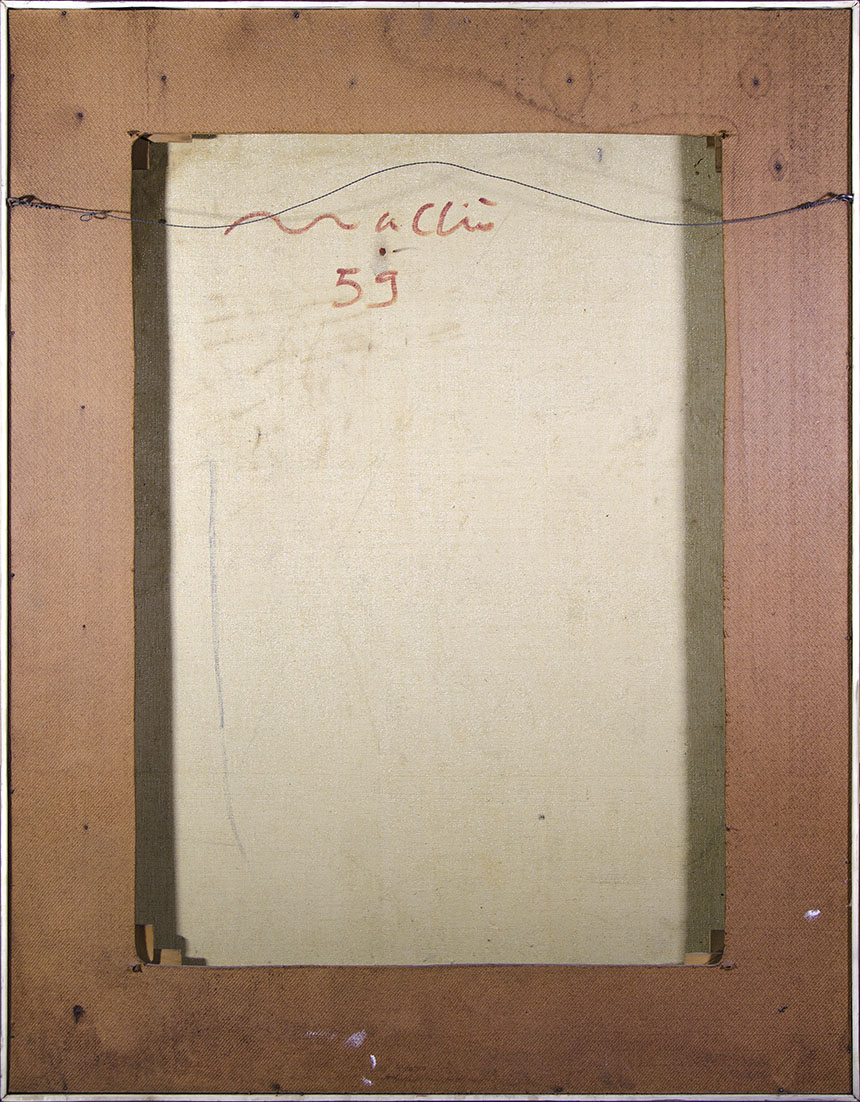BACK TO TOP
ART
No title. 1959.
Oil on canvas. Measurements: 80 x 60 cm. Signed on the painting, and signed and dated on the back. Work in excellent condition, framed.
A pale face emerges, distinguishing itself against a background in which vegetable figures also appear. Macció laid out a thick layer of vibrant blue, green, ocher colors on the canvas, and with a piece of wood -usually the tail of a brush- he painted the contours of the composition on the still-fresh canvas, that is, he drew by removing matter, exposing once more the framework of the fabric, at the same time that it generated a relief on the sides of the negative line.
To understand the context in which Macción painted this work in 1959, let us quote the critic Laura Buccellato: “Macció held his first exhibition at the Galatea Gallery, in 1956. His surrealist tendency was visible then. One can speak of a prehistoric period in Macció's work, which would cover approximately from 1956 to 1960, in which he moved through lyrical abstraction and tried to free himself from the strict limits of previous constructive and mandatory painting, by choosing the path of the emotional and instinctive During this stage he was part of the group 'Boa' (1958). This very heterogeneous group of artists, formed by the critic Julio Llinás, had a common denominator: a certain psychic automatism. Its members, Martha Peluffo, Osvaldo Borda, Víctor Chab, Clorindo Testa, Kazuya Sakai, Josefina Robirosa and Rogelio Polesello, edited a magazine and were in contact with the group 'Phases International' in Paris. It is necessary to take into account Macció's fidelity to easel painting at a time when the tendency of avant-garde artists was to move away from the canvas as a support for their experiences, in an anguished search for a new plastic truth interrelated with the apocalyptic development. of world facts and the tangible approximation to cosmic spatiality caused by the advancement of science and technology. A time when the 'grand gesture' escapes verbal language and the concept becomes the true protagonist of the artistic act. But nothing disturbs the passion of Macció, who continues to be linked to the language of painting with a stubborn obsession. Breaking with the classic abstraction-figuration dichotomy, Macció incorporated a certain figuration into his informal experiences. In a context where abstraction still prevailed in its two meanings, geometric and gestural, he tried a new way of 'figuring', that is, of returning to figuration”. [1]
In that 1959 Macció won the De Ridder Prize and exhibited at the Witcomb Gallery in Buenos Aires. Could it be that this work was exhibited in that show, and acquired there by its previous owner? We have not found, if it was done, with his catalog. Two years later, in 1961, together with the artists Luis Felipe Noé, Ernesto Deira and Jorge de la Vega, he exhibited at the Peuser gallery, an act in which one of the most influential movements of the second half of the 20th century emerged: New Figuration. .
Born in Buenos Aires, Rómulo Macciò (1931 - 2016) was a self-taught painter. He carried out important and innumerable solo shows, since his first exhibition at the Galatea Gallery in 1956. Among other awards, he obtained the First International Prize from the Torcuato Di Tella Institute in 1963, the Guggenheim Award in 1964 and the Grand Prize of Honor from the National Salon in 1967. He represented Argentina at the Venice Biennale in 1968 and 1988, at the Paris Biennale in 1969 and at the Sao Paulo Biennale in 1963 and 1985. His work is part of the heritage of important institutions, such as the National Museum of Fine Arts Arts, the Guggenheim Museum in New York, the Museum of Modern Art in Paris and the Center for Contemporary Art in Madrid.
Note:
1. Laura Buccellato, Maccio. In Argentine Painters of the 20th Century, Latin American Publishing Center, Buenos Aires, 1982. S.O.XXII - GLSMM| AUTHOR | RÓMULO MACCIÓ |
|---|
Are you interested in selling some works?
Send us an email briefly indicating
which works you intend to put on sale, and we will respond. click here
Subscribe to our newsletter to be updated.
Check our Newsletters

